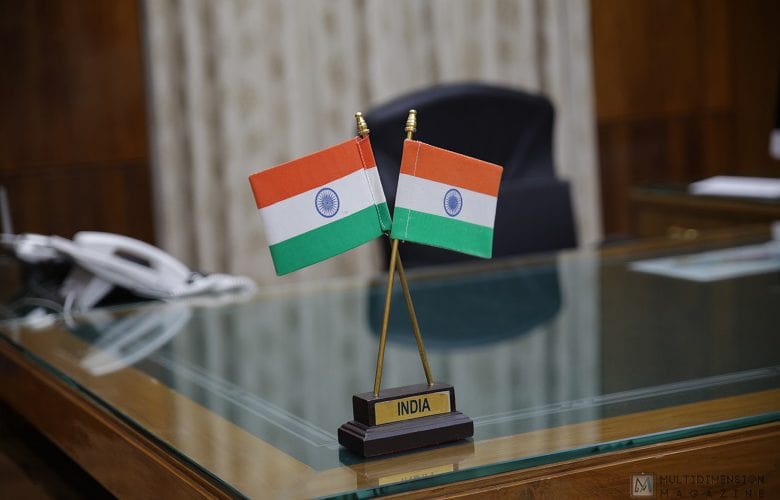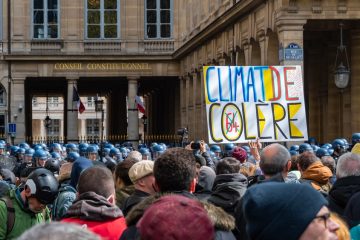Written by : Dr. Anup Shekhar Chakraborty
Photo credit : Shutterstock.com
From the Rhythm to Dystopia
Pre-COVID 19 India was engaged in altering its Federal rhythm while the world embattled the novel coronavirus. The monolith of exceptional leadership within the BJP came to be questioned with conflicting commands from the PMO and the Home Ministry on issues such as the NRC and Modi’s weakening position in front of the surge of Amit Shah amidst the Delhi riot during Trump’s 24-25 February 2020 visit. The tensions in the altering federal rhythm were furthered by the failure of the opposition parties and the left intelligentsia to cope with the issue of CAA and NRC. Significant problems in the altering federal rhythm included the abolition of ‘Article 370’ and the‘Triple Talaq’. A number of experts linked the disgruntledness to religious bigotry, political agenda of Hindutva, and the Centre’s excesses. Thus, the federal rhythm off-tuned few states gave knee-jerk reactions in a manner that those are no more part of India. The central leadership of the BJP kept itself busy in a game of political brinkmanship until mid-March 2020 in an attempt to install its government in Madhya Pradesh. The ‘Corona’ till then had not taken over the conversations within the federal order, and the Health Ministry on 13 March 2020 had declared that Covid-19 was ‘not a health emergency.’ The pre-COVID 19 India navigated with the politics of accusations and counter-accusations of ‘being anti-national,’ ‘saving Democracy,’ weeding the ‘Modi wave,’ scripting a counter-narrative to Modi and manufacturing a consensus among the fractured and disparate opposition through a ‘Mahagathbandhan.’ Bharat (the often-used word for rural India) was in parts in slumber and parts partially awaken to issues of the agrarian economy, market, and indebtedness. Sweeping across traditional barriers, political leanings, institutional affiliations, and geographies, India exhibited signs of dystopia.
The Virus and its Reception
The first officially reported and digitized COVID 19 case came from the southern Indian state of Kerela on 30 January 2020. It was also the first Indian state to take the Coronavirus spread as a severe health issue and opt to develop a plan of action to effectively combat the threat. The coming of the pandemic to India did not have its ripples of caution across the country. Mostly, due to the states’ conviction that‘everything is in order,’ or something would be ‘jugaad’ to mitigate the alien ‘Chinese’ virus. Social media across India was flooded with viral videos and narrations: the Lockdown in Wuhan; the technology-assisted life support that China was engineering to negotiate the virus; the Wuhan wet market that was believed to be the source of the killer virus and the alleged Chinese laboratories where this bio-warfare was created. In circulation, these videos did little to inject a sense of caution and preparedness to combat the globetrotting virus’s arrival in India. The unseriousness of the media (both real and virtual) further cemented the complacent character of its multitudes. The unseriousness of the television media could be gleaned through the period’s reportages, primarily through episodes of news channels inviting Bollywood playback singers to sing ‘Corona na Pyaar hai’ or ‘Corona na Corona.’ The English print media in India through December to March placed the pandemic in less critical pages. They preoccupied the readers with reports on the more saleable news of Anti-CAA, gully gully Shaheen Bagh, JNU and Jamia students protests, and the walking through the pandemic act of prominent opposition at the states.
These multiversal issues underscored the visit of the pandemic in India up till Modi’s televised call for a Janata Curfew on Sunday, 22 March 2020. Few opposition leaders went on record to assert their opinions and suspicion of the center governments cautions of the pandemics’ new travel destination, i.e., India. The Centre’s message and warnings were rubbished as failure to come to talk with the protestors and the disgruntled across India. The left-liberal section of the intelligentsia and the opposition parties in India took to seize the virtual public sphere through out-of-turn and out-of-place speaking. They accused the BJP and the Prime Minister of shielding itself behind the virus and that the virus was a lie. The virus and Modi were trying to divide India and spread hate, homogenize, and Hinduise, those protesting sought to unite and spread love, tolerance, and message of secularism. The narratives across the different political communications mediums conjured upbeatness and collective pride among those who protested against the juggernaut called Modi. The left-liberals and political scions went on record to say that the contagious virus’s narrative was a sham to break and disperse the protestors (which had ample visibility of women, most of whom were attired in burkhas and wore the hijab) of the many Shaheen Baghs across urban India. Overall the PMO had a daunting task before Modi could take back control of the situation by announcing Janta Curfew.
The day selected for the Janata Curfew was a Sunday, and the Janata responded to the Prime Minister’s call for solidarity and expression of gratitude at a select time applauding the ‘Corona Yoddhas’ (frontline workers during the pandemic) through clapping of hands, beating of utensils, blowing of conches. News channels telecast these images in real-time. The collective response of people (Janata) going out to their balconies and to the streets to applaud was unthinkable. Modi could consolidate back his position only after the hugely successful nation-wide response to the call for lighting up candles and change the narrative from religion to national health emergency and the necessity of inter-state dialogues.
The opposition and the left-liberals were taken aback at the response Modi received. The left-liberals trolled the government for choosing a Sunday for a Janata Curfew. They challenged the government to select any other day and see the open defiance of Modi’s call. The Shaheen Baghs across the country from Delhi to Park Circus in Kolkata defied the call of Janata Curfew in the wake of the coronavirus pandemic.
The Contagion and the Contagious
The contagious nature of the virus, its impact on ‘public health’ and ‘public order’ began to slowly yet surely engage the social imaginaries of good health, well being, and sanitization. The mass media in all its formats had successfully spun the diverse narratives of social imaginaries into a political one of protecting the nation from the threat of a common enemy and singling the source of the spread of the virus. The manufactured enemy identified as the ‘virus carrier’/ ‘superspreaders’ and a threat to the nation was the Tablighi Jamaat collectives. followed by hashtag movements such as “corona Jihad,” “Corona Terrorism,” and “Corona Bombs Tablighi.” Such strategies offered grand narratives of combating an alien virus and communalizing its spread. In the narration of Corona virus’s visit to India, the story of Tablighi Jamaat and the ensuing debates on ‘responsible/irresponsible behavior’ and the holding of the entire Muslim community responsible for the nation-wide spread of the virus forms the braid of the Contagion and the contagious. Questions that loom significant include how more than a thousand people stayed inside a campus without the police’s knowledge and the administration right under the government’s nose following the National Capital Region’s communal riots.
Locking the Nation: ‘Stay Home, Stay Safe’
Charting a nation-wide response to the Lockdown and its differential effects is a daunting task. The nation-wide Lockdown in India(by invoking the Disaster Management Act of 2005) has not gone without its share of discrepancies and unsettledness. In all its phases, the Lockdown has sent tremors and ripple effects in India’s federal order. The states have accused the Centre of not consulting them before calling the closure. The Centre has remained tight-lipped and maintained an official silence leaving things befuddled. The response to the pandemic directly touched on two core areas, namely ‘public health’ and ‘public order,’ both placed in the State List of the Indian Constitution. The issue of control and regulation of the spread of the contagious disease is in the Concurrent List, and the overall disbursal of finances are with the Centre.
The official response to the Lockdown’s criticisms seems to tell that this was evident and needed no clarification; it was common-sense. The message in the bottle was that the Janata Curfew was a prelude to the Lockdown. However, the idea of the nation-wide Lockdown in just a few hours was imprudent, also, not considering the issue of migrant workers with state governments compounded the dystopia.
The media, in its disparate platforms, documented the official commands and the protesting voices. The Lockdown 0.1 phase, in minimal ways, conveyed the contagious nature of the virus and required behavioural mechanisms to remain unlearnt. The political communications of the Centre and the health and social distancing guidelines were ridiculed and belittled in the virtual public sphere and defied in the physical. The Lockdown response differed across the regions, the Northeastern states like Mizoram, Nagaland, Meghalaya, and Sikkim showed exemplary feats during the lockdown phases and in wayfinding a reaction to the virus through negotiations and synchronizations of logistics amidst precarity and outdated resources. However, this wayfinding lost their sheen during the unlocking stages, and the infected cases increased multifold with the homecoming of the migrants from elsewhere in trains and other transport. Again, it drove the point that ‘Locking’ and ‘Unlocking’ required differential recalibrations of strategies.
The lethality of the virus had not settled in the collective imaginaries of the people, which was in sync with the images and videos in circulation in the social media, the newsroom chats, reportage, etc. The gravity of the pandemic downplayed. The communication for social distancing, staying indoors, work from Home, the school from Home, no pink slips to workers, no salary cuts, etc. remained mostly unintelligible. Indians were negotiating with new times. The left-liberals strummed a cacophony projecting India as a fascist state with restricted right to mobility, bodies caged in quarantine centers, and the migrants irrespective of class and job differentials subjected to new norms of sanitization, intrusive technologies, and routine testing including thermal scans at various points of exits and entries.
The sanghis (a common shorthand for the umbrella of the Sangh Parivaar) in predictable response countered the narratives with viral videos, and messages to justify the time and duration of the Prime Minister’s communication to the nation lines of ‘graha- nakshatra’ (astrology and astronomy). The sanghis strummed the narrative that India would beat the virus out of the country by clapping, playing drums, blowing conch shells, crackers, and lighting lamps. India suddenly took refuge in belief in supernaturals, in contrast to the expected ideals of scientific temper. The left-liberals trolled the sanghis oblivious of similar references to supernatural beliefs and destiny from their turf equating the NPR, NRC, and CAA to black magic, or that the summer heat would kill the virus or the strain that entered India would be a weak one. The virus would die on its own or bank on the destiny of herd immunity, which in operation is epidemiological neoliberalism.
Locking, Unlocking and the Home bound
The center’s later phases of the Lockdown gave a freer hand to the states to mitigate and negotiate the virus. However,few states felt it was too late to collect their logistics in order and face the wave of migrant returnees. The states and the Centre continued to accuse each other of fudging data relating to COVID 19 deaths. Queries related to the COVID 19 from the Centre were interpreted as an intrusion to alter the federal rhythm. The endless pictures in circulation in the media of migrants walking back Home created new brownies to be scored between the political parties and governments in power at the states and the Centre, and the opportunity to photo-document the plight of the least advantaged in dystopic times of the pandemic. The questions that loomed largely were why were the migrants forced to walk back home? Who ousted them in the first place? Why were lockdown norms not adhered, and why did the states not gate the passages and the highways? Why were the migrants not provided a safe, secured, and sanitized shelter? The governments at the state have accused the Centre’s sudden Lockdown without consultation to be the answer to the unpreparedness to regulate and address the internal migrants’ plight. The Centre’s defense to this has been that internal migration in India is a state subject. With the rise in numbers, the struggle between the states and the Centre has worsened. Each state is spinning its strategies and negotiations with the Centre. The situation in the national capital of Delhi is appalling with the governments discrediting each other and engaging in constant pressure, throttle, and truce.
The coming of the migrants to their ‘Desh’ (home states, ancestral villages as we call it in South Asia) marks uncanny resemblance to the restive response to the coming of the alien virus. The migrant like the virus is seen as the source of the problem to be quarantined so that everybody else is safe and sanitized. The uneven logistic grids and the urban dystopia remain unruffled by the coming of an unwanted guest. The virtual public sphere also began to examine and challenge existing ideas about migrants critically. Who is a migrant? Who is a local (Bhoomiputra)? The traditionally accepted cleavages such as caste, ethnicity, linguistics, and the appendages of class, education, etc. are all embroiled into the broth of a complicated grid of a migrant in contemporary India. The lack of strategies and coordination for improving migrant workers’ plight has exposed the severe defect in India’s federal structure and enfeebled the idea of a Union of States.
The left-liberals and the sanghis by the closure of the lockdown phase 0.4 realized the COVID 19 pandemic gravity. They controlled themselves from exhibiting their virtual diarrhea. However, few political parties and their leaderships continued to showcase their skills in communicating politically senile statements and declaring the Lockdown a failure as it could not control the numbers. These statements signaled that the leadership failed to grasp the purpose of the Lockdown. The Lockdown was to procrastinate the spread of the virus and to give time to the country/community to find its mechanisms of negotiating the virus.
New Domesticity and recalibrations
The Lockdown and the unlocking period became an opportunity for celebrities (local, regional, national) to video-document their ordinariness. Gendered constructions of household chores waned under the Lockdown and a new domesticity of engaging in washing dishes, cooking, sweeping, and sanitizing took center stage. Also, essential questions echoed through the virtual public sphere were related to the lack of sanitizers in the markets and the need to redefine ‘essential commodities’ in India.
The unlocking is a new game altogether requiring recalibrations of newly acquired behavioural changes to negotiate the virus during the Lockdown. We miss to understand that the virus is a new version of an older one and is still shifting its strains/traits, virologists and experts are grappling to comprehend it. Medication is still in the process of making. The phases of Lockdown gave way to the stage of unlocking, the Centre and the states in India began to converse in a language intelligible to each other. They churned the mantra from Jaap Goudsmit’s book, Viral Fitness (2004), of ‘living with the virus’ to serve their distinctive ends. The message that we take Home is that the virus has come and that it has decided to be an overstaying guest. The governments in all its hierarchies and its multifaceted linkages will not take responsibility for individual lives. All that humans have learned in the past 100 years in terms of sociability, staying connected, and the evolved idea of the magic of the human touch, health, sanitation, hygiene, medication, and medical interventions changed overnight from Wuhan to Washington and Oslo to Ushuaia. Sanitizers, social distancing, Masks became the gadgets or gears of isolation and protection. These recalibrations of the ‘Social,’ ‘Health,’ and technology-mediated experiences, have reintroduced alienation of a newer version. These are new motifs around which Indians will have to recalibrate and negotiate their every day and engage with newer assemblages of the pandemic and the dystopia.
(The views expressed in this article are the author’s own and do not necessarily reflect Multidimension’s editorial stance.)
Dr. Anup Shekhar Chakraborty
Assistant Professor, Department of Political Science and Political Studies, Netaji Institute for Asian Studies, & member, Mahanirban Calcutta Research Group, Kolkata




